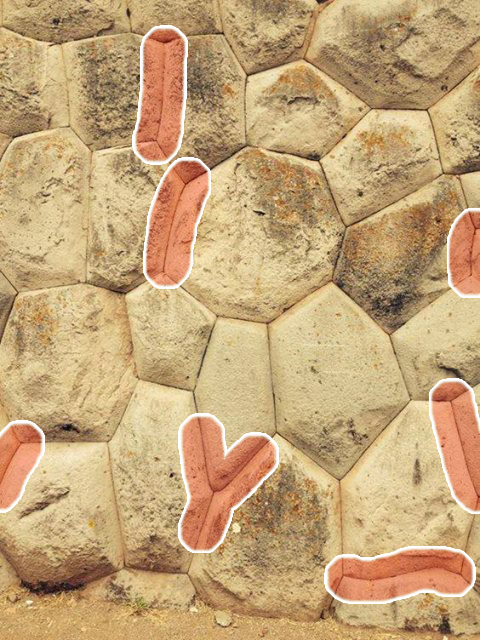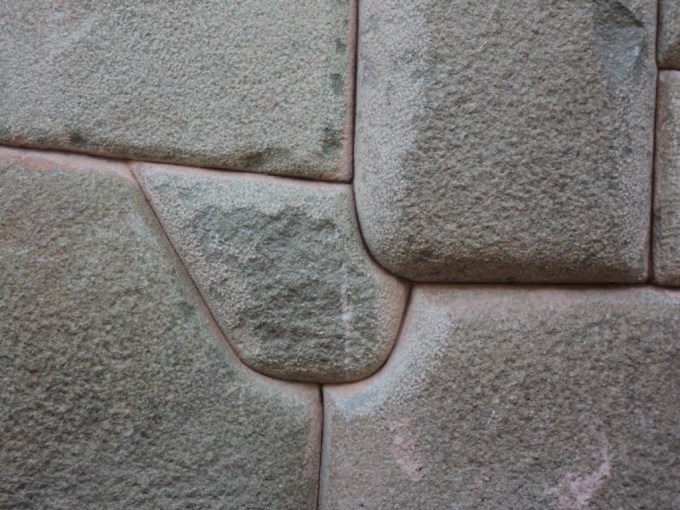Have you ever been baffled by something only to then, when putting some thought into it, come to a sudden realization? Call it an epiphany, but such was my case with ‘Incan’ architecture. I had always been puzzled by the perfect fittings and how they might have been achieved. They say you can’t fit a piece of paper into the seams. It was only when I actually set my mind to re-creating them that it dawned on me.
The photograph below is what did it. It was the joints that got my attention, and their curved faces. If you can figure out how to make the curves fit, the rest is just stacking, after all. I had always been under the impression that all the faces were flat. The curves made it much harder to do, or so I thought, but therein lay the secret. That which seemed to make it impossible was key to discovering the elegant simplicity in the method.

As it turns out, to build such a structure, one does not even need any tools. Using tools would be considered doing things the ‘easy way’. But the ‘easy way’ isn’t always the easiest way.
1 Kings 6:7
For the house, when it was in building, was built of stone made ready at the quarry; and there was neither hammer nor axe nor any tool of iron heard in the house, while it was in building. (JPS)Exodus 20:22
And if thou make Me an altar of stone, thou shalt not build it of hewn stones; for if thou lift up thy tool upon it, thou hast profaned it. (JPS) (Exodus 20:25 in many English translations)
Now, I’m not a big fan of the bible, nevertheless, it was an interesting discovery to think that stones could be fashioned without tools, and that ancient man had, apparently, also figured this out.
When one has no metal tools, one figures out ways to do things without them. When one has metal tools, their use becomes ubiquitous and is then considered the only way. Most times, new technology replaces old technology and leaves no trace of ancient methods behind. Efficiency is usually gained in the exchange, but not always, at least, not for certain tasks.
I think the reason that this technique has not been considered is that when looking at a wall, we tend to look at it as a two-dimensional surface, and we forget it has depth (not to mention our modern, cultural, and architectural biases.)
It occurred to me, while looking at the patterns in the stonework, that the octagonal stone near the middle of the image could simply be pulled out from its setting and the wall would still stand. I slid it out in my mind, and slid it back into place. That’s when I saw it.
If one were to rub two round stones together, eventually they would each develop a flat face which would then be perfectly mated to its neighbour. If those stones had similar flat sides to begin with, the process would be that much easier and quicker. If such a flat side were not perfectly flat, rather, showed some concavity, rubbing the convex face of another stone against it would produce a curved joint. (Rubbing side-to-side and perpendicular to the long axis of the wall.)
[Incidentally, the only way to make a perfectly flat surface, in those days, would have been to rub two stones in the manner described. Having done this, a straight edge could then be formed by rubbing a piece of wood against a flat rock. I cannot think of any other way for primitive man to fashion a perfectly flat surface, or a perfectly straight edge. As it turns out, straight lines were a natural rarity until we, as Douglas Adams once wrote, learnt to bang the rocks together.]
So there it is. The process would be simple enough. Partly bury two stones with mated faces next to each other, and find a third stone which would roughly fit the space between the protruding tops of those buried stones. Rub it sideways until it fit perfectly, wipe away the grit between them, and repeat the process, stacking the stones as you go. It would not matter if there was overlap or if the stones were of unequal size. Incidentally, the grit would act as both an abrasive and a lubricant making it easier to rub the stones against each other.
I think that building a stone wall in this way would take much less time and energy than was previously thought. Wouldn’t it be something if it could be shown that Puma Punku was built in under a year, and by a small crew? Stones could be roughly hewn or not. Perhaps the stones were just found by the wayside without need of quarrying at all.
There are several megalithic sites around which no tools have been found. Could simple techniques such as these be the reason?
I have approached several universities and researchers with this project, but to my surprise, none have taken an interest. Are there any adventurous folks out there who want to build a wall with me this summer? Let me know on the ‘Drawing Board’ page.
